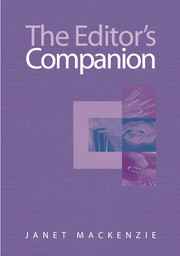Book contents
- Frontmatter
- Contents
- List of illustrations
- Preface
- 1 The editor in context
- 2 The publishing process
- 3 Management and liaison
- 4 Substance and structure
- 5 Language
- 6 Illustrations and tables
- 7 Completeness and consistency
- 8 Proofs
- 9 Editing methods
- 10 Working with documents and files
- 11 Freelance editing
- Appendix: Australian Standards for Editing Practice
- Notes
- Select bibliography
- Index
1 - The editor in context
Published online by Cambridge University Press: 05 June 2012
- Frontmatter
- Contents
- List of illustrations
- Preface
- 1 The editor in context
- 2 The publishing process
- 3 Management and liaison
- 4 Substance and structure
- 5 Language
- 6 Illustrations and tables
- 7 Completeness and consistency
- 8 Proofs
- 9 Editing methods
- 10 Working with documents and files
- 11 Freelance editing
- Appendix: Australian Standards for Editing Practice
- Notes
- Select bibliography
- Index
Summary
Editing for publication is a little-known occupation. The common impression is that it consists of correcting grammar and punctuation, which it does, but the job has many other aspects that make it endlessly absorbing. If you are suited to it, editing is the best fun you can have at a desk.
What makes a good editor? Editors share a defining characteristic: they love ideas and words and books. In a world of increasing specialisation, most are generalists. Reflecting the female domination of the book industry, almost all of them are women.
Two contradictory stereotypes prevail. One is the Jacquie Onassis type, who has languorous lunches with celebrity authors and swans about with the literati at the best parties. The other is the eagle-eyed, anal-retentive, obsessive frump who flays inoffensive manuscripts with her punitive pencil. In fact, editors who fit either of these stereotypes don't get far. Editors have been compared to midwives, surgeons and even chameleons, but the most apt simile is inorganic: ‘Good editors may be likened to those crystal-clear prisms which form a vital part of a pair of binoculars. They are not there to alter the view or change the scene, but to make it clearer and closer.’
Editorial skills
The profession of editing rejects all but paragons with an extraordinary array of virtues:
Communication skills: Editors are articulate and communicate lucidly in writing; they can write in various registers and styles and take on the voice of an author.
[…]
- Type
- Chapter
- Information
- The Editor's Companion , pp. 1 - 17Publisher: Cambridge University PressPrint publication year: 2004



